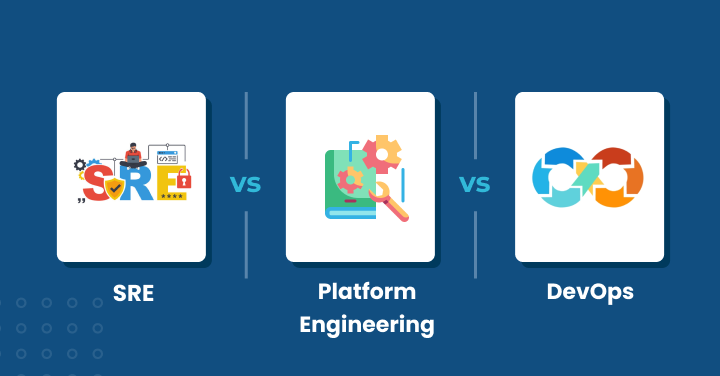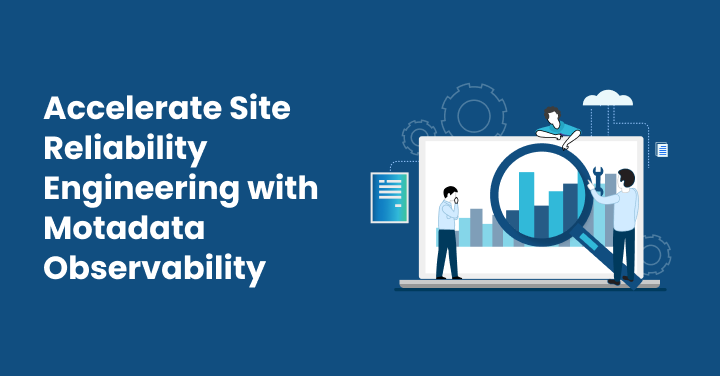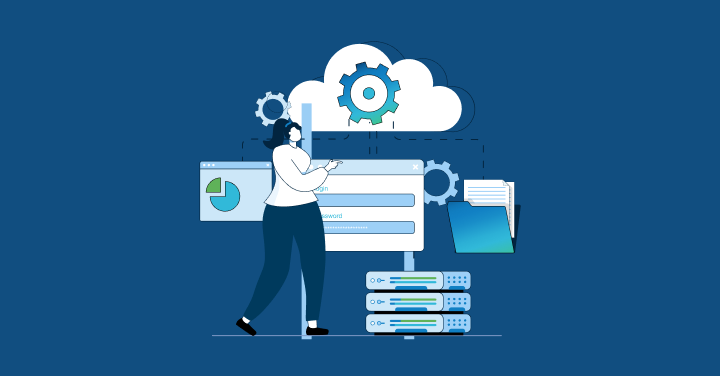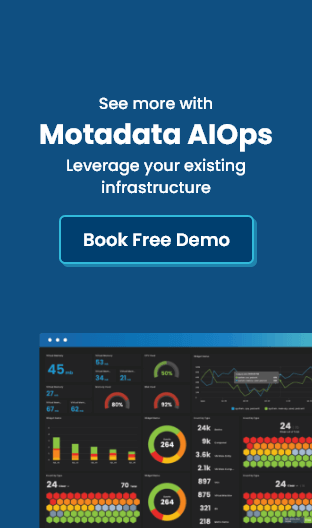Site Reliability Engineers (SREs) are the invisible backbone of the internet—without them, your favorite apps would crash daily. Competing in the evolving digital world was no longer possible with traditional IT practices.
Hence, many businesses integrated SRE into modern IT landscapes to keep the systems running smoothly. SRE is a key practice that enhances system reliability and application performance by automating tasks, monitoring system health, and resolving issues in real time. However, as technology evolves, their job is becoming increasingly complex.
Even the most skilled SRE teams struggle to manage rapid deployments, complex cloud environments, and intricate microservices. This is where AIOps (Artificial Intelligence for IT Operations) comes into play.
AIOps for SREs are not a substitute but can be a game-changer that will amplify their capabilities.
Incorporating AIOps tools for SREs can help proactively prevent failure and drive reliability at an unprecedented scale. Leveraging AI-driven insights is not about replacing human expertise but elevating it.
This blog will bring more clarity into the site reliability engineer AIOps role. We’ll uncover the core principles and capabilities of SREs and AIOps tools, unlock the benefits of AIOps for SREs, and explore the role of SRE in AIOps.
SRE & AIOps: Understanding the Dynamic Duo – Foundations for a Reliable Future
Site Reliability Engineering (SRE) is a discipline that focuses on operations, reliability, infrastructure performance, and scalability of systems.
In SRE, professionals integrate software engineering approaches to operations to build scalable systems. Some of the core principles of SRE approach include:
- Automation: SREs prioritize automation to minimize human error and save time. Automating routine tasks, such as monitoring system health, deployments, incident response management, etc., can improve overall system efficiency. Further, it helps engineers to focus on more strategic tasks.
- Data-Driven Decisions: SREs rely on data and metrics to drive decisions regarding system performance. They collect and analyze large volumes of data to proactively address issues and optimize operations.
- Shared Ownership: SREs promote a culture of shared responsibility between development and operations teams. Rather than working in silos, they collaborate to design and maintain reliable, scalable systems.
- Focus on Toil Reduction: Manual and repetitive tasks are time-consuming and difficult to sustain as the system scales. SREs actively work to reduce repetitive, manual, and operational tasks that add no long-term value to your business by automating processes, creating playbooks to streamline tasks, and improving efficiency.
- Embracing Failure: Failure is common in complex distributed systems. SREs understand it and adopt a mindset of learning from incidents rather than avoiding them. Encouraging transparency and analyzing failures help prevent future outages and improve system resilience.
On the other hand, AIOps (Artificial Intelligence for IT Operations) is a new practice that involves artificial intelligence and machine learning practices to manage complex data, track patterns, and faster resolution time. The core principles of AIOps practice include:
- Anomaly Detection: AIOps constantly monitor IT operations and alerts to identify any unusual pattern in the system using machine learning algorithms. Be it unauthorized access, system failure, etc., it triggers alerts in real-time.
- Root Cause Analysis: AIOps correlates logs, metrics, and traces to identify the root cause of the problem and provide actionable insight.
- Predictive Analytics: AIOps leverages historical data and machine learning models to predict potential issues and needs for future resources. It further identifies elements that are at risk of failure.
- Automated Remediation: Apart from identifying issues in real-time, these tools also provide solutions and updates to prevent vulnerabilities. AIOps reduces manual workload and builds trust by automating the issue resolution process.
- Intelligent Alerting: AIOps tools can filter out false positives and prioritize incidents that can have a significant impact. Thus, it ensures that IT teams receive relevant and actionable alerts, which will eventually improve response efficiency.
The Power of Partnership: SRE and AIOps – Better Together
Site Reliability Engineering (SRE) and Artificial Intelligence for IT Operations (AIOps) are not competitors but complementary forces working together to enhance system reliability.
SRE brings human expertise and deep operational knowledge, whereas AIOps enhances SRE capabilities with AI-powered intelligence and automation. Together, they form a powerful duo and complement each other in the following ways:
- AIOps Automates SRE Toil: Toils are manual and repetitive tasks. AIOps reduces toil with automation and saves time. It automatically performs key tasks such as log analysis, anomaly detection, and incident response, allowing SREs to focus on strategic initiatives.
- SREs Guide AIOps Implementation and Strategy: While AIOps is a powerful tool, it requires careful implementation and alignment with business needs. SREs are crucial in guiding AIOps strategies, defining key performance indicators (KPIs), configuring AI models, and ensuring that automation is correctly applied to operational workflows.
- AIOps Provides Data-Driven Insights for SRE Decisions: By analyzing large datasets, AIOps can detect patterns, predict potential failures, and suggest optimizations that enhance system reliability. These valuable insights help SREs proactively address issues before they escalate.
- SRE Expertise is Crucial for Interpreting AIOps Outputs: While AIOps generates valuable recommendations, human expertise is still essential for interpreting these insights. SREs bring contextual knowledge, and understanding of the broader implications of AI-driven suggestions and make informed decisions that align with both technical and business goals.
The Evolving SRE Role: From Reactive Firefighters to Proactive Architects of Reliability
The role of Site Reliability Engineers (SREs) is rapidly evolving with the adoption of AIOps, shifting from manual, reactive work to proactive, strategic contributions.
Traditionally, SREs spent significant time on repetitive tasks like incident response, alert handling, and monitoring.
AIOps automate these functions, reducing operational toil and allowing SREs to focus on improving system reliability and efficiency.
AIOps also strengthens the DevOps culture by providing a shared, data-driven platform that enhances collaboration between development and operations teams. Automating workflows across both domains fosters a more integrated and efficient approach to software delivery and reliability.
Furthermore, SREs are now playing a crucial role as AIOps integrators and strategists. They guide adopting AI-driven tools, customizing them to suit organizational needs, interpreting insights, and optimizing processes.
This strategic shift empowers SREs to drive continuous improvements, ensuring long-term system resilience and efficiency.
SRE Responsibilities in an AIOps World: Supercharged by AI Intelligence
With the introduction of AIOps practice, the role of Site Reliability Engineers (SREs) has evolved significantly. Here are some of the key responsibilities of SRE in an AIOps-powered environment.
Incident Management – AIOps-Powered Rapid Response and Root Cause Analysis
AIOps has improved incident management with its AI algorithms and capability to detect and suggest potential root causes in real time.
Traditional monitoring practices usually take more time to figure out the problem and are error-prone. With AIOps, SREs receive real-time anomaly detection alerts and recommendations for resolution.
Instead of relying only on manual reports, it analyzes historical data, log patterns, and dependency mappings to pinpoint the root cause of failures faster. Thus, it reduces downtime and allows SRE teams to focus less on remediation and analysis.
Proactive Automation and Predictive Maintenance – Building Self-Healing Systems
AIOps provides SREs with insights that drive proactive remediation strategies. By analyzing system performance trends and identifying recurring patterns, generative AI assists in automating key functions such as capacity planning, scaling, and performance optimization.
It helps detect early warning signals of potential failures and prevent delay or problem escalation. Intelligent automation also mitigates issues before they escalate, reducing system downtime and improving overall efficiency.
Monitoring and Observability – Real-Time Analytics and Intelligent Insights
AIOps revolutionizes monitoring and observability by providing data-driven SREs with real-time analytics. It turns raw monitoring data into actionable insights indicating potential performance degradation, security threats, or resource utilization.
Further, AIOps observability ensures that anomalies are detected early, which helps reduce the meantime for detection (MTTD).
Resource Optimization – AI-Driven Efficiency and Cost Savings
AI-powered analytics assess infrastructure utilization, identify resource bottlenecks, and predict future capacity needs.
This allows organizations to right-size their infrastructure and prevent over-provisioning or underutilization. SREs can better manage resource distribution, cost, and scale strategies by leveraging these insights.
Collaboration and DevOps Partnership – AIOps as a Shared Platform
AIOps platforms are a collaborative hub that brings together SREs, DevOps teams, and other stakeholders. By providing a common language and shared data-driven insights, AIOps fosters improved communication and teamwork.
AI-powered automation ensures that operational insights are seamlessly integrated into the development pipeline, allowing teams to address reliability concerns proactively during the software development lifecycle. This leads to improved service resilience and collaboration.
Unlocking SRE Potential: The Tangible Benefits of AIOps Adoption
Some of the key benefits of AIOps for SREs are:
Enhanced Proactive Capabilities & Faster Issue Resolution
- Enhanced Predictive Capabilities: AIOps uses AI and ML techniques to address potential issues before they impact performance. They track patterns and predict failures, allowing teams to take preventive measures in advance. This predictive capability helps in reducing downtime.
- Real-Time Anomaly Detection: Compared to traditional monitoring tools, AIOps identifies anomalies faster and more accurately. This detection at an early stage results in faster response times and reduces the burden of unnecessary alerts on SRE teams.
- Improved Incident Prioritization: AIOps intelligently categorize alerts based on their severity level. Rather than manually sifting through numerous notifications, SREs can rely on AIOps to highlight the most critical incidents that require immediate attention. Thus, priority issues were initially resolved, and service disruption was reduced.
- Streamlined Root Cause Analysis: Traditional troubleshooting methods take longer to analyze and track system performance issues. AIOps automates this process by analyzing vast amounts of data, pinpointing correlations, and providing actionable insights. This not only accelerates issue resolution but also reduces downtime.
Improved Efficiency & Resource Management
- Efficient Resource Allocation: AIOps can track usage patterns of resources and system performance. Using these insights, team members can gain more visibility into resource consumption, helping scale IT infrastructure dynamically and prevent over-provisioning.
- Reduction in Manual Effort (Toil Reduction): AIOps help reduce toil by automating repetitive tasks such as log analysis, performance monitoring, and incident resolution. SREs can focus on higher-value activities such as innovation and strategic improvements by offloading these tasks to AI-driven automation.
- Faster Deployment and Testing: Traditional software release cycles often involve extensive manual testing and monitoring that can be time-consuming. AIOps accelerates the deployment process by automating testing, monitoring performance in real-time, and providing actionable feedback. This enables teams to release updates more quickly while maintaining system performance.
Scalability & Cloud Readiness
- Seamless Hybrid Cloud Management: As organizations move towards hybrid and multi-cloud environments, managing complex infrastructures becomes increasingly challenging. AIOps simplifies hybrid cloud management by providing a unified view of distributed systems and automating operational tasks. It enables seamless integration across different cloud platforms, ensuring consistent performance.
- Support for Scaling Operations: As businesses expand, the complexity of IT environments grows, making manual intervention impractical. AIOps addresses this challenge by dynamically adjusting resource allocation, optimizing system performance, and predicting capacity needs. This guarantees IT systems remain responsive, even as demand scales up. Further, by enhancing cloud readiness, AIOps empowers organizations to embrace cloud-native architectures without compromising reliability.
Enhanced Collaboration
- Improved Collaboration Across Teams: AIOps is a centralized communication platform for IT operations, development, and security teams. It eliminates silos and enables teams to work together seamlessly. By automatically correlating incidents, alerts, and logs, AIOps ensures that all members can access relevant insights in real time.
Navigating the AIOps Journey: Challenges for SREs and How to Overcome Them
The following are the key challenges for SREs adopting AIOps tools:
Technical Hurdles
- Data Dependency & Quality: AIOps heavily relies on high-quality, well-structured data to generate meaningful insights. However, this is not true, as the data collected comes from various IT systems. Hence, the gathered data can be inconsistent or incomplete, resulting in inaccurate analysis. Further, it may cause false alerts or missed incidents, making it difficult for SREs to trust AIOps-driven decisions.
- Tool Integration Complexities: Many organizations already use suitable monitoring and log analysis tools. Integrating AIOps with existing monitoring, incident management, log analysis tools, and more can be challenging. Each tool may have its format, protocol, or API. Ensuring seamless communication between AIOps platforms and current infrastructure demands extensive customization and compatibility testing.
- Scalability Challenges: Organizations with distributed or complex systems generate large volumes of operational data daily. AIOps solutions must be capable of processing this extensive data in real time and generating actionable insights. However, a few AIOps platforms in the market find it difficult to scale efficiently.
Organizational & Human Factors
- Steep Learning Curve: To run AIOps tools smoothly, you must have a solid understanding of data science, automation, AI, and machine learning concepts. These skills are generally not a part of an SRE’s traditional skill set. Hence, learning to configure and interpret AIOps models can take more time and effort, which can be another barrier.
- Cultural Resistance to AI: Many team members often find sticking to traditional monitoring and troubleshooting methods suitable. Concerns over job displacement, loss of control, or AI making incorrect recommendations can lead to resistance from both leadership and technical team members.
- Over-Reliance on AI & “Black Box” Concerns: Many AIOPS tools use complex machine learning algorithms that do not always explain their recommendations clearly. If SREs cannot understand why AI suggests specific actions, they may struggle to trust its insights.
Implementation & Cost Considerations
- High Initial Investment: There are various expenses that an organization needs to keep in mind when deploying AIOps tools, such as purchasing software, integrating it with existing systems, and training employees to use it effectively. These upfront costs can be a significant deterrent, especially for smaller organizations with limited budgets.
- Maintaining AI Models: Over time, IT environments have entirely changed. AI models initially trained on historical data may become outdated, leading to inaccurate predictions and ineffective automation. Hence, it is essential to regularly train and fine-tune AI models that demand more resources and expertise for quality results.
- Security Concerns: AIOps tools have a higher risk of becoming potential targets for cyber threats as they collect and analyze large data sets from multiple sources. Ensuring that AIOps platforms follow stringent security protocols, encrypt sensitive data, and comply with regulatory requirements is crucial for preventing data breaches and unauthorized access.
The Future is Intelligent: SREs Leading the Charge in an AIOps-Driven World
The future of Site Reliability Engineering (SRE) is being reshaped by the rise of Artificial Intelligence for IT Operations (AIOps), enabling a shift in focus from routine maintenance to innovation and strategy.
As AIOps technology advances, AI will take over repetitive operational tasks such as incident response, log analysis, and performance monitoring.
With AIOps for SRE, engineers can concentrate on higher-level initiatives and strategies. Rather than limiting to fixing operational issues, SREs will play a more strategic role in shaping the future of system reliability and efficiency.
To thrive in this evolving IT environment, SREs must develop new skills that align with AIOps-driven workflows—a good understanding of AI and machine learning concepts and data science is a must.
Further, SREs must encompass strong data analysis capabilities and expertise in automation. Strategic thinking capabilities can additionally help in making more informed decisions.
Apart from skills, having the proper knowledge of tools is essential. These include observability platforms that help collect and correlate data from various sources like logs, metrics, traces, and events to provide real-time system insights, anomaly detection tools that identify potential problems before they escalate, and automation frameworks that streamline operational workflows.
By embracing these skills and technologies, SREs will adapt to an AIOps-driven world and better redefine IT operations for the future.
Conclusion: SREs at the Forefront of Intelligent Reliability
The collaboration between SREs and AIOps represents a powerful transformation in IT operations. AIOps does not replace SREs but enhances their ability to maintain, optimize, and innovate site reliability practices.
By automating repetitive tasks, providing intelligent insights, and enabling predictive maintenance, AIOps allows SREs to focus on higher-level strategies and improvements.
As SREs embrace AIOps, they enter a future where proactive reliability, intelligent automation, and strategic innovation define their role.
By harnessing AI-driven tools, SREs can ensure resilient, high-performing, and scalable systems, driving the future of IT operations.
FAQs:
Site Reliability Engineers (SREs) is a key practice that bridges the gap between software development and IT operations. They focus on automation, monitoring, and performance optimization to reduce downtime and build scalable IT systems by applying software engineering principles to operations.
SREs define reliability goals and automate processes, while AIOps use artificial intelligence to detect issues, predict failures, and reduce operational noise. AIOps helps SREs by providing actionable insights into system behavior and automating incident response. AIOps for SRE can be a game changer as they can reduce manual effort, enhance system performance, and minimize downtime.
SREs use artificial intelligence and machine learning practices to monitor systems, identify patterns, and identify anomalies in real time before they escalate. Further, using these AIOps tools, engineers can predict potential failures and take preventive actions. Alert automation also helps reduce response time and enhance system stability.
Implementing AIOps comes with various challenges, such as a data dependency learning curve in understanding different concepts of AI and machine learning techniques. Misconfigured tools can sometimes generate too many alerts for users, making the team miss priority ones.






